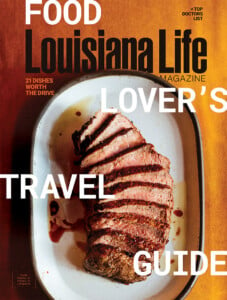Meandering Through Opelousas’ Spiritual Trail
A Glimpse into Acadiana History

Leonville Grotto
Each of our journeys contains three parts. First comes the anticipation. For days, months or years, we look forward to our departure. Then, finally, that day arrives. We travel, some of us, to leave behind our everyday lives, hoping to unearth better versions of ourselves. Others seek new spices or sunsets, any variation of the ordinary that urges us to see our own neighborhood with new eyes. Once home again, we embark upon another adventure. Shuffling through the memories of our journey, we hold them close, some for the rest of our lives.
At times, we may saunter, wandering without expectation. At others, we travel with purpose.
Last year, the Pilgrims Reception Office in Santiago de Compostela, Spain, reported that 499,242 travelers received a certificate for completing the journey along the Camino de Santiago, or Way of St. James, one of the world’s most popular pilgrimages for Christians. In Opelousas, Zydeco Music Capital of the World and Louisiana’s third oldest city, the St. Landry Parish Tourist Commission offers its own itinerary for those who pursue more purposeful journeys. The Spiritual Trail comes with a digital passport for travelers to “stamp” while visiting historical buildings, churches, cemeteries and other religious and secular landmarks. St. Landry Parish Tourist Commission Communications Manager Mary Hawkins recommends that visitors start the trip at the eco-friendly Tourist Commission visitor center in Opelousas.

Amédé Ardoin Statue
“You can find pretty much all the ecosystems represented in Louisiana here in St. Landry,” she says. “Our grounds represent those ecosystems. We use sustainable materials, solar panels, a wind turbine.” After a brief pause, she continues: “And we have a statue of Amédé Ardoin.”
In performances and recordings released between 1930 and 1934, the Creole accordionist Ardoin planted the seeds for zydeco while revolutionizing Cajun and Creole music — all before age 44, when, in 1942, he was committed to Louisiana’s state psychiatric hospital in Pineville after a beating left him mentally incapacitated. Six weeks later, he died as Case No. 13387.
After paying homage to Ardoin’s legacy and earning the first stamp, travelers might drive 12 miles southeast to Leonville, where the stone grotto at St. Leo the Great Catholic Church features a statue of Bernadette, who beheld the first of her 18 apparitions of the Virgin Mary at Lourdes in 1858. Another 10 miles to the southwest, travelers reach Grand Coteau and the grounds of St. Charles Borromeo Catholic Church, where the 3,104-pound bell chimes while silent retreaters pray along live oak-shaded paths.

Grand Coteau Grounds
Back in Opelousas, two Catholic churches within blocks of one another await the traveler: Holy Ghost, which harbors the largest African American congregation in the United States, and St. Landry, where a statue of Fr. Verbis Lafleur rises above parishioners. A volunteer in the U.S. Army during World War II, Lafleur spent two years in Japanese prisoner of war camps. There, he ministered to soldiers of all faiths and advocated for prisoners’ rights despite beatings from his captors. His case for sainthood opened in 2020.
A mile away, Le Vieux Village offers a collection of Creole-style structures from the late 1700s to the mid-1900s. It also includes the Union Pacific Railway depot that now houses the Louisiana Orphan Train Museum. “In the 1850s, the New York City chief of police estimated 10,000 children on the streets with nowhere to go,” says museum volunteer Charlie Roy. “Those circumstances led several organizations, including the New York Foundling Hospital, to send children across the country by train for adoption. Between 1907 and 1927, 2,000 children arrived in Louisiana from the Foundling Hospital.” Roy’s grandfather, Martin Arvine Roy, travelled on the first train. He was two weeks old. In 1942, he became mayor of Opelousas.

Orphan Train Museum
“Families in Opelousas could request children with a certain hair color or eye color, so when they left the Foundling Hospital, they were already assigned a home,” Roy says. Inside this well-curated museum run by volunteers, a stirring stop along the trail, he walks beside displays of clothing that children wore on the journey. “They arrived with one numbered tag sewn into their clothes and another hung around their neck. Families knew which number to look for.” Children old enough to talk arrived speaking English in a French-speaking culture.
The path toward a life-changing experience on the other side of the world — island hopping in the Mediterranean or on African safari, say — becomes even more possible when we push ourselves to have altering experiences in our own neighborhood. Pilgrimages such as the Spiritual Trail offer that combination of leisured wandering and journeying with the kind of intent that opens new corridors inside the once-familiar — in other words, travel at its most meaningful.

St. Borromeo
Location | St. Landry Parish
Did you know? The Spiritual Trail includes 19 sites throughout St. Landry Parish, among them the Academy of the Sacred Heart/Le Petit Musée, the Ave Maria Shrine, Cedar Hill Cemetery, the Creole Heritage Folklife Center, Hebrew Rest Cemetery, Le Vieux Village Heritage Park, the Historic Michel Prudhomme Home, the Louisiana Orphan Train Museum and Our Lady of the Oaks Retreat House.
